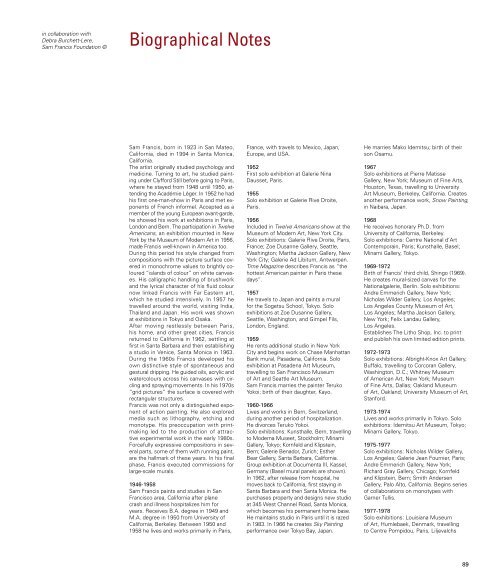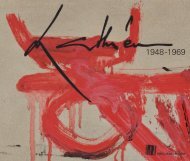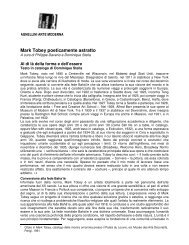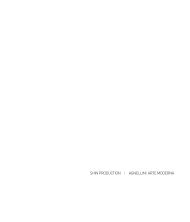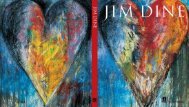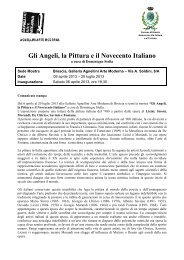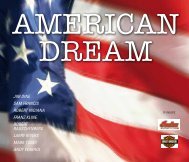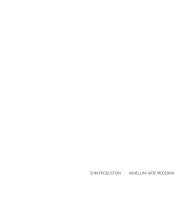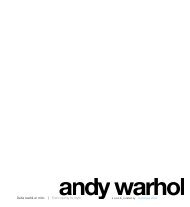Sam Francis - Agnellini Arte Moderna
Sam Francis - Agnellini Arte Moderna
Sam Francis - Agnellini Arte Moderna
Create successful ePaper yourself
Turn your PDF publications into a flip-book with our unique Google optimized e-Paper software.
in collaboration with<br />
Debra Burchett-Lere,<br />
<strong>Sam</strong> <strong>Francis</strong> Foundation ©<br />
Biographical Notes<br />
<strong>Sam</strong> <strong>Francis</strong>, born in 1923 in San Mateo,<br />
California, died in 1994 in Santa Monica,<br />
California.<br />
The artist originally studied psychology and<br />
medicine. Turning to art, he studied painting<br />
under Clyfford Still before going to Paris,<br />
where he stayed from 1948 until 1950, attending<br />
the Académie Léger. In 1952 he had<br />
his first one-man-show in Paris and met exponents<br />
of French informel. Accepted as a<br />
member of the young European avant-garde,<br />
he showed his work at exhibitions in Paris,<br />
London and Bern. The participation in Twelve<br />
Americans, an exhibition mounted in New<br />
York by the Museum of Modern Art in 1956,<br />
made <strong>Francis</strong> well-known in America too.<br />
During this period his style changed from<br />
compositions with the picture surface covered<br />
in monochrome values to brightly coloured<br />
“islands of colour” on white canvases.<br />
His calligraphic handling of brushwork<br />
and the lyrical character of his fluid colour<br />
now linked <strong>Francis</strong> with Far Eastern art,<br />
which he studied intensively. In 1957 he<br />
travelled around the world, visiting India,<br />
Thailand and Japan. His work was shown<br />
at exhibitions in Tokyo and Osaka.<br />
After moving restlessly between Paris,<br />
his home, and other great cities, <strong>Francis</strong><br />
returned to California in 1962, settling at<br />
first in Santa Barbara and then establishing<br />
a studio in Venice, Santa Monica in 1963.<br />
During the 1960s <strong>Francis</strong> developed his<br />
own distinctive style of spontaneous and<br />
gestural dripping. He guided oils, acrylic and<br />
watercolours across his canvases with circling<br />
and spraying movements. In his 1970s<br />
“grid pictures” the surface is covered with<br />
rectangular structures.<br />
<strong>Francis</strong> was not only a distinguished exponent<br />
of action painting. He also explored<br />
media such as lithography, etching and<br />
monotype. His preoccupation with printmaking<br />
led to the production of attractive<br />
experimental work in the early 1980s.<br />
Forcefully expressive compositions in several<br />
parts, some of them with running paint,<br />
are the hallmark of these years. In his final<br />
phase, <strong>Francis</strong> executed commissions for<br />
large-scale murals.<br />
1946-1958<br />
<strong>Sam</strong> <strong>Francis</strong> paints and studies in San<br />
<strong>Francis</strong>co area, California after plane<br />
crash and illness hospitalizes him for<br />
years. Receives B.A. degree in 1949 and<br />
M.A. degree in 1950 from University of<br />
California, Berkeley. Between 1950 and<br />
1958 he lives and works primarily in Paris,<br />
France, with travels to Mexico, Japan,<br />
Europe, and USA.<br />
1952<br />
First solo exhibition at Galerie Nina<br />
Dausset, Paris.<br />
1955<br />
Solo exhibition at Galerie Rive Droite,<br />
Paris.<br />
1956<br />
Included in Twelve Americans show at the<br />
Museum of Modern Art, New York City.<br />
Solo exhibitions: Galerie Rive Droite, Paris,<br />
France; Zoe Dusanne Gallery, Seattle,<br />
Washington; Martha Jackson Gallery, New<br />
York City; Galerie Ad Libitum, Antwerpen.<br />
Time Magazine describes <strong>Francis</strong> as “the<br />
hottest American painter in Paris these<br />
days”.<br />
1957<br />
He travels to Japan and paints a mural<br />
for the Sogetsu School, Tokyo. Solo<br />
exhibitions at Zoe Dusanne Gallery,<br />
Seattle, Washington, and Gimpel Fils,<br />
London, England.<br />
1959<br />
He rents additional studio in New York<br />
City and begins work on Chase Manhattan<br />
Bank mural, Pasadena, California. Solo<br />
exhibition at Pasadena Art Museum,<br />
travelling to San <strong>Francis</strong>co Museum<br />
of Art and Seattle Art Museum.<br />
<strong>Sam</strong> <strong>Francis</strong> marries the painter Teruko<br />
Yokoi; birth of their daughter, Kayo.<br />
1960-1966<br />
Lives and works in Bern, Switzerland,<br />
during another period of hospitalization.<br />
He divorces Teruko Yokoi.<br />
Solo exhibitions: Kunsthalle, Bern, travelling<br />
to <strong>Moderna</strong> Museet, Stockholm; Minami<br />
Gallery, Tokyo; Kornfeld and Klipstein,<br />
Bern; Galerie Benador, Zurich; Esther<br />
Bear Gallery, Santa Barbara, California.<br />
Group exhibition at Documenta III, Kassel,<br />
Germany (Basel mural panels are shown).<br />
In 1962, after release from hospital, he<br />
moves back to California, first staying in<br />
Santa Barbara and then Santa Monica. He<br />
purchases property and designs new studio<br />
at 345 West Channel Road, Santa Monica,<br />
which becomes his permanent home base.<br />
He maintains studio in Paris until it is razed<br />
in 1983. In 1966 he creates Sky Painting<br />
performance over Tokyo Bay, Japan.<br />
He marries Mako Idemitsu; birth of their<br />
son Osamu.<br />
1967<br />
Solo exhibitions at Pierre Matisse<br />
Gallery, New York; Museum of Fine Arts,<br />
Houston, Texas, travelling to University<br />
Art Museum, Berkeley, California. Creates<br />
another performance work, Snow Painting,<br />
in Naibara, Japan.<br />
1968<br />
He receives honorary Ph.D. from<br />
University of California, Berkeley.<br />
Solo exhibitions: Centre National d’Art<br />
Contemporain, Paris; Kunsthalle, Basel;<br />
Minami Gallery, Tokyo.<br />
1969-1972<br />
Birth of <strong>Francis</strong>’ third child, Shingo (1969).<br />
He creates mural-sized canvas for the<br />
Nationalgalerie, Berlin. Solo exhibitions:<br />
Andre Emmerich Gallery, New York;<br />
Nicholas Wilder Gallery, Los Angeles;<br />
Los Angeles County Museum of Art,<br />
Los Angeles; Martha Jackson Gallery,<br />
New York; Felix Landau Gallery,<br />
Los Angeles.<br />
Establishes The Litho Shop, Inc. to print<br />
and publish his own limited edition prints.<br />
1972-1973<br />
Solo exhibitions: Albright-Knox Art Gallery,<br />
Buffalo, travelling to Corcoran Gallery,<br />
Washington, D.C.; Whitney Museum<br />
of American Art, New York; Museum<br />
of Fine Arts, Dallas; Oakland Museum<br />
of Art, Oakland; University Museum of Art,<br />
Stanford.<br />
1973-1974<br />
Lives and works primarily in Tokyo. Solo<br />
exhibitions: Idemitsu Art Museum, Tokyo;<br />
Minami Gallery, Tokyo.<br />
1975-1977<br />
Solo exhibitions: Nicholas Wilder Gallery,<br />
Los Angeles; Galerie Jean Fournier, Paris;<br />
Andre Emmerich Gallery, New York;<br />
Richard Gray Gallery, Chicago; Kornfeld<br />
and Klipstein, Bern; Smith Andersen<br />
Gallery, Palo Alto, California. Begins series<br />
of collaborations on monotypes with<br />
Garner Tullis.<br />
1977-1978<br />
Solo exhibitions: Louisiana Museum<br />
of Art, Humlebaek, Denmark, travelling<br />
to Centre Pompidou, Paris, Liljevalchs<br />
89


